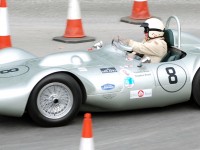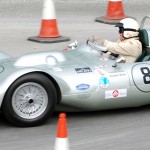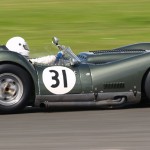
Lister Cars is a British sports car manufacturer.
Beginning in 1954, company manager and racing driver Brian Lister brought out the first in a series of sports cars from a Cambridge iron works. Inspired by Cooper, he used a tubular ladder chassis, de Dion rearaxle, and inboard drum brakes. Like others, he used a tuned MG engine and stock gearbox. It made its debut at the British Empire Trophy at Oulton Park in 1954, with the skilled, and light, (former MG pilot)Archie Scott Brown at the wheel. Good as he was, Scott Brown could not make up the Lister-MG’s deficiencies against superior competition, so Lister swapped in a Moore-tuned Bristol two litre engine and knockoff wire wheels in place of the MG’s discs. For the sports car race supporting the 1954 British Grand Prix at Silverstone, Scott Brown easily won the two litre class and placed fifth overall, ahead even ofC-Jags, behind only works Astons. The Lister-Bristol spent the rest of the 1954 season proving this was no fluke, beating Maseratis, Cooper-Masers, and even Lotus-Bristols.
In 1955, a handful of Lister-Bristols were built with a new body by ex-Bristol man Lucas, claimed to have been designed with the aid of a wind tunnel. Despite its finsand strakes, it was less dominant than the ’54, and competition was only getting stronger. With this in mind, in 1954 Lister moved up to a six cylinder F2 A6GCS, from the very Maseratis he had beaten in 1954, for his own works drivers, while privateers (mostly club racers) got the Bristol (at ₤3900). The Lister-Maser was as conquering as the Lister-Bristol before it. Lister’s magic did not extend to single-seater racing, however; his F2 car, with Coventry-Climax power, MG gearbox, and (new to Lister) multi-tube chassis, proved a failure.
For 1957, Lister redesigned the car around a D-Jag inline-six, with an aerodynamic aluminium body, the most refinement in a Lister yet, and performance, finally, sufficient to beat the Astons; it was tested by racing journalist John Bolster to a 0-100 mph (0–160 km/h) of 11.2 seconds. Scott Brown proved its quality, winning the 1957 Empire Trophy.
Refined again in 1958, with a sleeker body and better brakes, Lister-Jag still forced Scott Brown and Masten Gregory, the main works drivers, to work for their few successes against Ferraris and Astons, and Scott Brown crashed fatally at Spa.
Seeing the tough competition, Lister belatedly hired Frank Costin, “the most competent aerodynamicist in the business”, who produced the most beautiful, and best, Lister yet. Despite this, and the Chevrolet-powered Lister-Corvette, it was not enough, for the new rear-engined Cooper pointed to the future, and Lister closed up. In all, only fifty or so cars were built.
Brian Lister was chosen by the Rootes Group to prepare the 1963 Sunbeam Tiger Le Mans cars for the Prototype category of the famous 24-hour race. The Ford V8 powered Tiger was still in early stages of development and the Lister Le Mans cars were from the first batch of cars made at the Jensen factory. Lister beefed up the suspension and brakes, added an aerodynamic fastback hardtop with a more sloping windscreen and a Kamm tail. The 260 cu in (4,300 cc) Ford V8 engine was tuned by Shelby (the maker of the original prototype from a Sunbeam Alpine) to give it 275 hp (205 kW) instead of the stock 160 hp (120 kW). The cars were designed with a top speed of 170 mph (270 km/h) but were developed in too short a time frame and both failed with engine failures blamed on sloppy preparation by Shelby. Rootes later received a refund for the engines. The two cars and one prototype ‘mule’ still exist. ADU 179B is owned by a UK enthusiast and ADU 180B by a Californian.

